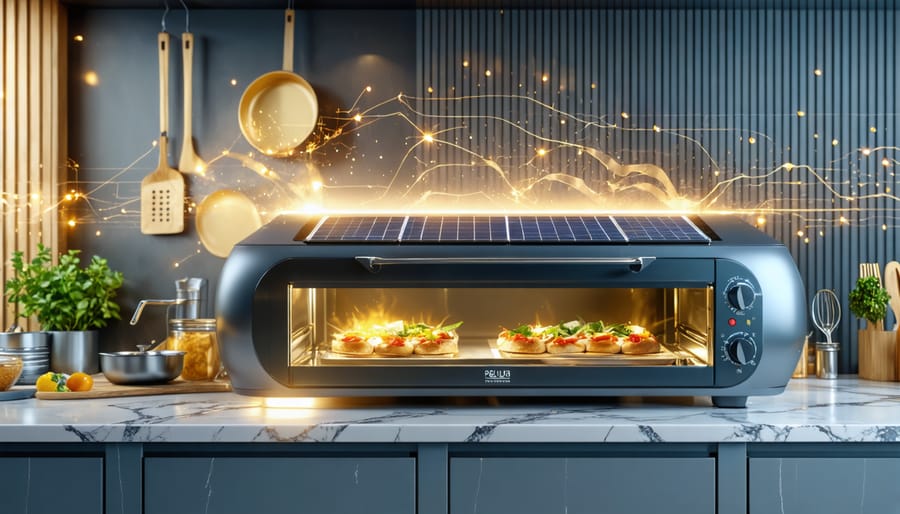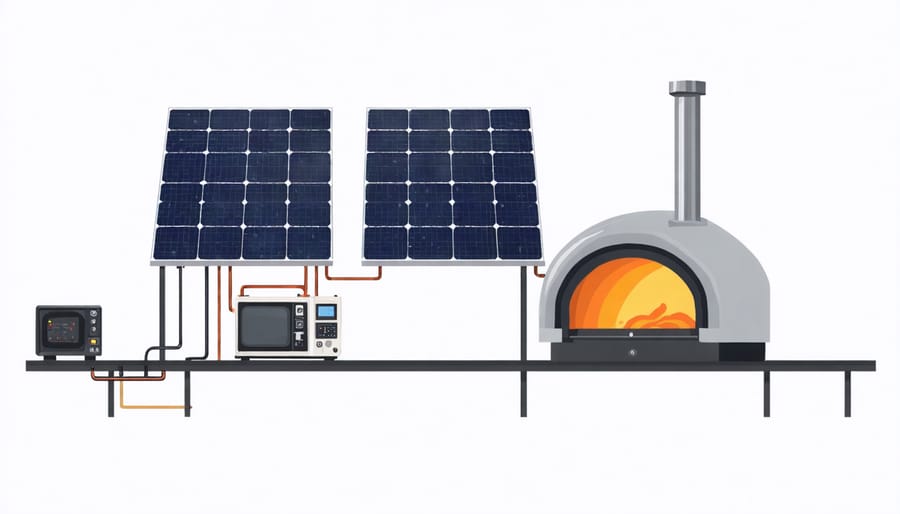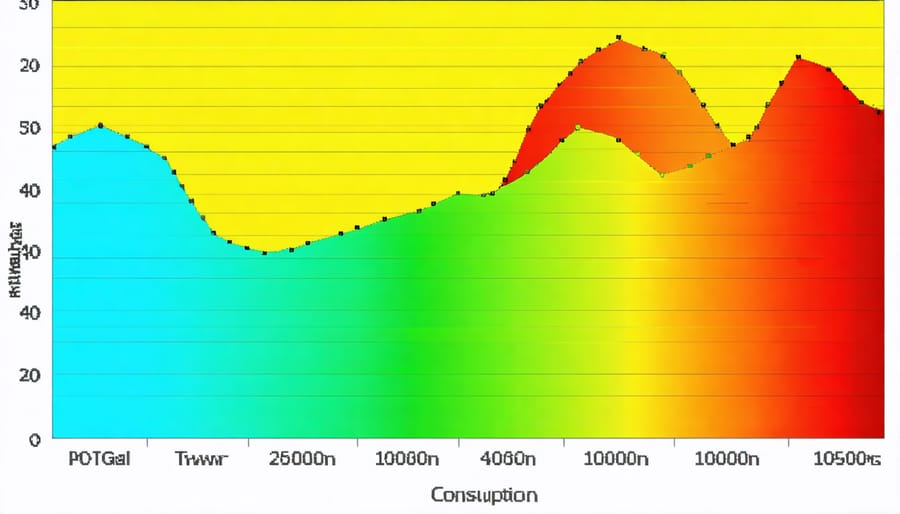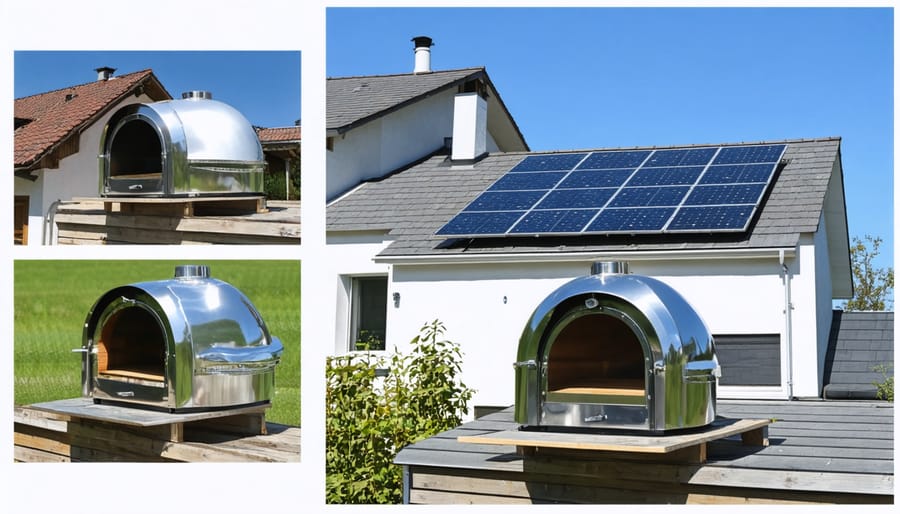This Smart Hybrid Solar Oven Cuts Your Kitchen’s Energy Bills in Half

Transform your kitchen into an energy-efficient powerhouse with hybrid solar ovens – the revolutionary appliance that combines traditional electric cooking with clean solar energy to slash your power bills. These innovative systems seamlessly switch between solar and conventional power sources, ensuring consistent cooking performance regardless of weather conditions while reducing energy consumption by up to 70%.
Unlike traditional solar cookers, hybrid models integrate smoothly with existing kitchen setups, requiring minimal modifications to your home’s infrastructure. Advanced thermal storage technology maintains cooking temperatures even after sunset, while smart controls automatically optimize energy usage based on available sunlight and cooking requirements.
European homeowners pioneering this sustainable technology report significant reductions in household energy costs while maintaining the precise temperature control and reliability of conventional ovens. With enhanced insulation and dual-power capabilities, these systems represent the next evolution in sustainable home cooking, offering a practical solution for environmentally conscious households without compromising on modern culinary demands.
How Hybrid Solar Ovens Transform Your Kitchen
Dual-Power Technology
Hybrid solar ovens represent a significant advancement in sustainable cooking technology by seamlessly integrating two power sources: solar energy and conventional electricity. This dual-power approach ensures consistent cooking capabilities regardless of weather conditions or time of day. During sunny periods, the oven primarily utilizes solar energy captured through specially designed reflective panels and thermal collectors, converting sunlight into cooking heat.
The innovative electrical backup system automatically activates when solar power becomes insufficient, such as during cloudy weather or after sunset. This transition happens seamlessly through sophisticated sensors and control systems that monitor available solar energy levels. The electrical component typically operates at 220-240V, aligning with European household standards, and includes energy-efficient heating elements that complement the solar thermal system.
What makes this technology particularly effective is its intelligent power management system, which optimizes energy usage by blending both power sources when needed. For instance, during partially cloudy conditions, the system might use 70% solar power supplemented by 30% electrical power, ensuring optimal cooking temperatures while minimizing grid electricity consumption. This flexibility makes hybrid solar ovens particularly suitable for European climates, where solar conditions can be variable.

Smart Integration Features
Modern hybrid solar ovens come equipped with sophisticated connectivity features that seamlessly integrate with existing home solar systems to maximize your home’s energy potential. These smart integrations include WiFi-enabled monitoring systems that allow users to track energy consumption, cooking temperatures, and solar efficiency through dedicated mobile applications.
The intelligent control systems automatically switch between solar and electrical power sources based on available sunlight and energy prices, ensuring optimal efficiency throughout the day. Many models feature programmable timers and remote operation capabilities, enabling users to start cooking while away from home and receive real-time notifications about cooking progress.
Advanced models incorporate machine learning algorithms that adapt to local weather patterns and user preferences, optimizing energy usage accordingly. The integration with home energy management systems allows for coordinated operation with other solar-powered appliances, creating a synchronized ecosystem that enhances overall household energy efficiency.
These smart features also provide detailed analytics on energy savings and environmental impact, helping users make informed decisions about their cooking habits and energy consumption patterns.
Real Energy Savings for European Homes
Year-Round Performance
Hybrid solar ovens demonstrate remarkable adaptability across European seasons, offering consistent performance throughout the year. While traditional solar cookers may struggle during winter months or overcast days, hybrid models integrate seamlessly with home solar storage solutions to maintain reliable cooking capabilities regardless of weather conditions.
During summer months, these ovens primarily utilize direct solar energy, achieving temperatures up to 200°C through their advanced solar collectors. The hybrid functionality becomes particularly valuable during autumn and winter, when the system automatically supplements solar power with stored electrical energy to maintain optimal cooking temperatures.
The innovative thermal storage system retains heat effectively, enabling cooking even after sunset or during brief cloudy periods. This feature proves especially beneficial in Northern European regions, where daylight hours vary significantly between seasons. The oven’s smart control system continuously monitors available solar radiation and seamlessly transitions between energy sources to ensure uninterrupted operation.
Performance metrics show that hybrid solar ovens maintain 85-95% efficiency throughout the year, compared to conventional solar ovens that typically experience significant seasonal fluctuations. This consistent performance makes them a practical investment for European households seeking sustainable cooking solutions without compromising on reliability or convenience.

Cost-Benefit Analysis
The investment in a hybrid solar oven typically ranges from €800 to €2,500, depending on capacity and features. While this initial cost might seem substantial, the long-term savings justify the investment for many European households. Users report average energy savings of 60-75% on cooking-related electricity costs, translating to approximately €300-450 annually for a typical family of four.
The payback period varies based on usage patterns and local energy prices but generally falls between 3-5 years. Heavy users, such as small restaurants or community kitchens, might see returns in as little as 2 years. Beyond direct energy savings, these systems offer additional financial benefits through reduced cooling costs, as they generate minimal excess heat compared to conventional ovens.
Government incentives in various European countries can further improve the cost-benefit ratio. For instance, some regions offer tax rebates or grants covering up to 30% of the installation cost when integrated with existing solar systems. Maintenance costs are minimal, typically requiring only annual cleaning and occasional seal replacement, averaging €50-75 per year.
The durability of hybrid solar ovens, with an expected lifespan of 15-20 years, ensures continued savings well beyond the initial payback period. When factoring in rising energy costs across Europe, projected savings over the system’s lifetime can exceed €6,000 for residential users and significantly more for commercial applications.
Installation and Integration Guide

Technical Requirements
A hybrid solar oven requires several key components to function effectively and integrate with existing home systems. The primary element is a high-efficiency solar collector panel, typically measuring 2-3 square meters, which should be installed at a 30-45 degree angle for optimal sun exposure in European latitudes. The system must include a thermal storage unit, usually containing phase-change materials or high-density heat-retention mediums, capable of storing 2-5 kWh of thermal energy.
The backup heating element, powered by electricity or gas, requires a 220-240V AC connection common in European households, with power ratings ranging from 1000W to 2500W. Temperature control systems should maintain precise regulation between 50°C and 250°C, with digital controls offering ±2°C accuracy.
For system integration, the oven needs a compatible smart home interface supporting common protocols like WiFi, Zigbee, or KNX. The control unit should feature an IP54 or higher protection rating for kitchen environments. Essential safety features include automatic shutdown protection, temperature limiters, and pressure release mechanisms.
Installation requirements include adequate ventilation space (minimum 10cm on all sides), a load-bearing capacity of 40-60kg for mounting surfaces, and proper electrical grounding. The system should comply with EU energy efficiency standards and carry CE marking for European market compatibility.
Professional Support
Professional installation of hybrid solar ovens ensures optimal performance and seamless integration with existing kitchen systems. Many European solar energy providers now offer specialised installation services, combining technical expertise with local building regulations compliance. These professionals conduct thorough site assessments, determining the ideal positioning for maximum solar gain and evaluating your current electrical infrastructure.
Installation typically includes comprehensive system setup, calibration of hybrid components, and integration with home energy management systems. Certified technicians ensure proper ventilation, safety measures, and compliance with EU energy efficiency standards. The installation process usually takes 1-2 days, depending on complexity and existing infrastructure.
For ongoing maintenance, most providers offer scheduled service packages that include regular performance checks, cleaning of solar collectors, and calibration of hybrid systems. These maintenance contracts often feature remote monitoring capabilities, allowing technicians to identify and address potential issues before they affect performance.
Support services typically include:
– Annual system inspections
– Solar collector cleaning and maintenance
– Electronic component testing
– Efficiency optimisation
– Emergency repair services
– Performance monitoring and reporting
Many providers also offer warranty extensions and upgrade options as technology advances. To ensure long-term reliability, it’s recommended to schedule professional maintenance at least twice yearly, with additional checks before peak usage seasons.
Future-Proofing Your Kitchen
As the renewable energy sector continues to evolve, hybrid solar ovens are becoming increasingly sophisticated and adaptable. Current developments in smart home integration are paving the way for seamless connectivity between these ovens and other solar-powered home appliances, creating a more cohesive and efficient kitchen ecosystem.
Emerging technologies in thermal storage materials promise to extend cooking capabilities well beyond sundown, while advances in hybrid power management systems are improving the balance between solar and conventional energy sources. Manufacturers are developing more compact designs with improved insulation, making these ovens suitable for various kitchen layouts, from spacious country homes to urban apartments.
The scalability of hybrid solar ovens is particularly promising for commercial applications. Restaurants and catering services can potentially integrate multiple units into their operations, significantly reducing energy costs while maintaining consistent cooking performance. For residential users, modular systems are being developed that can expand cooking capacity as needed.
Integration with smart home systems is becoming a standard feature, allowing users to monitor energy usage, schedule cooking times, and optimize solar power utilisation through mobile applications. Future models are expected to incorporate artificial intelligence for better energy management and cooking performance prediction based on weather forecasts.
Looking ahead, we can expect to see innovations in materials that enhance durability and heat retention, along with more sophisticated hybrid systems that can automatically switch between energy sources based on availability and demand. The development of standardized connectivity protocols will ensure these appliances can easily integrate with existing and future home energy management systems.
For European households and businesses considering long-term kitchen investments, hybrid solar ovens represent a forward-thinking choice that aligns with the continent’s sustainability goals while offering practical, everyday benefits. As technology continues to advance, these systems will become increasingly efficient and user-friendly, making them an increasingly attractive option for modern kitchens.
The integration of a hybrid solar oven into your kitchen represents a significant step toward sustainable living and energy independence. By harnessing both solar power and conventional electricity, these innovative appliances offer unprecedented flexibility while substantially reducing your carbon footprint and energy costs. The dual-power capability ensures reliable cooking performance regardless of weather conditions, making it a practical choice for European households.
Through our exploration of hybrid solar ovens, we’ve seen how they can reduce household energy consumption by up to 70% during optimal conditions while maintaining the convenience of traditional cooking methods. The investment in such technology not only benefits the environment but also provides long-term financial returns through reduced energy bills.
As Europe continues its transition toward renewable energy solutions, upgrading to a hybrid solar oven positions your household at the forefront of sustainable kitchen technology. Whether you’re a passionate home cook or a business owner looking to reduce operational costs, these systems offer a practical pathway to greener operations without compromising on performance.
We encourage you to take the next step in your sustainability journey. Consider consulting with local solar energy specialists to assess your specific needs and explore available options for integrating a hybrid solar oven into your existing kitchen setup. By embracing this innovative technology today, you’re not just upgrading your kitchen – you’re investing in a more sustainable future for generations to come.
Leave a Reply